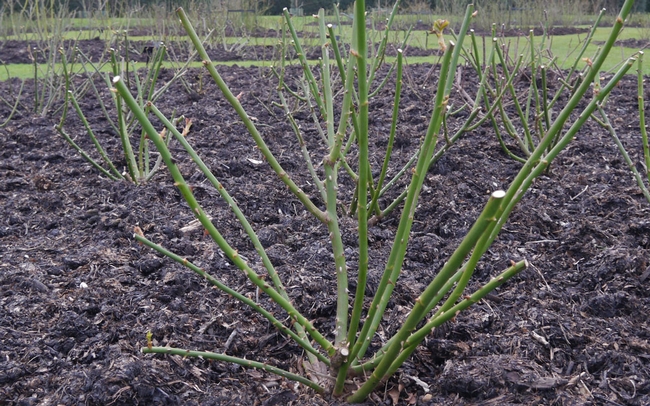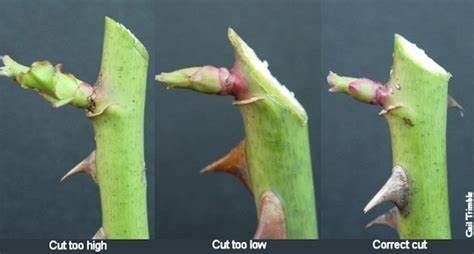- Author: Sara Milnes

Proper winter care is one key to healthy, beautiful roses. Not only do roses need to be pruned for health and good future bloom, but proper pruning is important to minimize diseases and insects during the growing season.
The goal of pruning is to remove dead, diseased, weak, and ill-placed canes and select strong healthy canes that will support the new year's growth. The rose needs an open center that allows for air circulation and sunshine in the middle of the plant.
In our mild climate area, pruning should be done in mid-January when the buds are still dormant. You'll need sharp hand clippers, loppers, a curved pruning saw and sturdy gloves for the project. Using Lysol spray on your tools between roses will help reduce the possibility of disease transmission.
Your aim is to have an attractive, vase-shaped bush with 5-7 healthy, well-spaced canes. While there's debate among experts as to how much to prune off, pruning back 1/3 to ½ of the growth is a good guideline in mild climates.
Most gardeners are too timid when pruning roses. Roses are remarkably sturdy and forgiving of mistakes. As Liz Druitt says in The Organic Rose Garden, “Pruning a rose bush is not unlike giving a home haircut to a small child; you do the best you can, secure in the knowledge that if it turns out odd-looking, new growth will quickly hide your mistakes.” Here are some tips for successful pruning.
Tip 1: When in doubt, cut it out.
Make a preliminary plan for what main canes to keep. You want to identify 5-7 new, green, sturdy canes to keep, ideally in a vase pattern. They should be larger than a pencil. If a cane is small, the stem coming off it will be even smaller. Cut any dead or diseased canes down to the bud union (the enlarged area just above the roots from which the main canes arise). Cut out any old craggy, gray canes that have no productive growth.
Cut out any cane crossing directly over the center of the plant, either where it comes off another cane, or at the bud union. You want to increase airflow and sunlight in the center of the plant. Cut out any cane that is seriously crowding another. If it's in the way, cut it away.
Remove any rootstock suckers that come from below the bud union by tearing them off in a downward direction to destroy potential buds, if possible.
The pruning diagram in this article shows the thinning cuts that remove weak, dead, and crossing branches in blue, while the heading cuts discussed in the next tip are shown in red.

Reduce the height of the canes by 1/3 to 1/2. Find an outward-facing dormant bud and cut about 1/4 inch above it at a 45 degree angle down and away from the bud (see diagram). Use the sharp end of the pruner towards the cane to assure a clean cut. The pith should be creamy white, not brown or gray. If a chosen cane is not healthy, cut further down until you reach healthy pith, or choose another cane.
If the main cane is horizontally spreading, an interior bud may be a better choice as it will grow more upright. If the roses have already flushed growth, prune back to a dormant bud. A bud that has already begun to grow will continue to grow vigorously and bloom very little, while a dormant non-growing bud will initiate growth after pruning and produce an abundance of blooms.
Cut off spindly, weak, deformed growth from the canes, and cut out canes that cross. Ideally remaining canes should be larger than a pencil. This is less important on floribundas, which generally branch more than hybrid tea roses. Avoid the temptation to leave small branches and stems.
Some agricultural extension articles recommend brushing away any old scaly wood on the bud union with a wire brush or knife to encourage future basal breaks (new shoots coming from the bud union). New shoots become the rejuvenating canes of the future.
Tip No. 3: Leave no leaves, and clean up well
Strip the bush of all leaves, as last year's leaves could harbor insects or diseases. Clean up all dead leaves, twigs, and dried petals, as they can harbor eggs, insects, and last year's fungus as well. Rose canes do not decompose well and spores and eggs can survive the compost pile, so it's best to put them in the green waste bin and not to home compost them.
Weed, tidy up, and lay down 2-4” of mulch, keeping it a few inches away from the plant. Step back and admire your handiwork!
While these instructions are for hybrid tea, grandiflora and floribunda roses, there are other types of roses—shrub, miniature, climbing, old roses, roses that bloom only once a season, newly planted roses—that have somewhat different requirements. The following resources are useful for all types of roses:
Roses: Cultural Practices and Weed Control: Pest Notes, Publication 7465
Ten Principles of Rose Pruning: Martin, Robert B., Consulting Rosarian
Pruning Roses: Evans, Mary, Tuolumne County Master Gardener
Horticulture Update: Solving the Mystery of Pruning Roses: Welsh, Dr. Doug, Landscape Horticulturist


